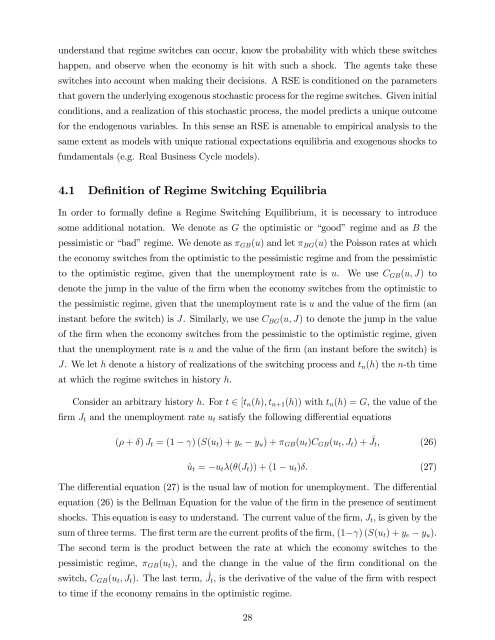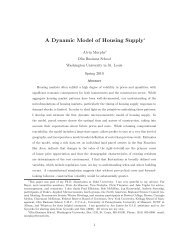Shopping Externalities and Self Fulfilling Unemployment Fluctuations*
Shopping Externalities and Self Fulfilling Unemployment Fluctuations*
Shopping Externalities and Self Fulfilling Unemployment Fluctuations*
You also want an ePaper? Increase the reach of your titles
YUMPU automatically turns print PDFs into web optimized ePapers that Google loves.
underst<strong>and</strong> that regime switches can occur, know the probability with which these switcheshappen, <strong>and</strong> observe when the economy is hit with such a shock. The agents take theseswitches into account when making their decisions. A RSE is conditioned on the parametersthat govern the underlying exogenous stochastic process for the regime switches. Given initialconditions, <strong>and</strong> a realization of this stochastic process, the model predicts a unique outcomefor the endogenous variables. In this sense an RSE is amenable to empirical analysis to thesame extent as models with unique rational expectations equilibria <strong>and</strong> exogenous shocks tofundamentals (e.g. Real Business Cycle models).4.1 De…nition of Regime Switching EquilibriaIn order to formally de…ne a Regime Switching Equilibrium, it is necessary to introducesome additional notation. We denote as G the optimistic or “good” regime <strong>and</strong> as B thepessimistic or “bad”regime. We denote as GB (u) <strong>and</strong> let BG (u) the Poisson rates at whichthe economy switches from the optimistic to the pessimistic regime <strong>and</strong> from the pessimisticto the optimistic regime, given that the unemployment rate is u. We use C GB (u; J) todenote the jump in the value of the …rm when the economy switches from the optimistic tothe pessimistic regime, given that the unemployment rate is u <strong>and</strong> the value of the …rm (aninstant before the switch) is J. Similarly, we use C BG (u; J) to denote the jump in the valueof the …rm when the economy switches from the pessimistic to the optimistic regime, giventhat the unemployment rate is u <strong>and</strong> the value of the …rm (an instant before the switch) isJ. We let h denote a history of realizations of the switching process <strong>and</strong> t n (h) the n-th timeat which the regime switches in history h.Consider an arbitrary history h. For t 2 [t n (h); t n+1 (h)) with t n (h) = G, the value of the…rm J t <strong>and</strong> the unemployment rate u t satisfy the following di¤erential equations( + ) J t = (1 ) (S(u t ) + y e y u ) + GB (u t )C GB (u t ; J t ) + J t ; (26)u t = u t ((J t )) + (1 u t ). (27)The di¤erential equation (27) is the usual law of motion for unemployment. The di¤erentialequation (26) is the Bellman Equation for the value of the …rm in the presence of sentimentshocks. This equation is easy to underst<strong>and</strong>. The current value of the …rm, J t , is given by thesum of three terms. The …rst term are the current pro…ts of the …rm, (1 ) (S(u t ) + y e y u ).The second term is the product between the rate at which the economy switches to thepessimistic regime, GB (u t ), <strong>and</strong> the change in the value of the …rm conditional on theswitch, C GB (u t ; J t ). The last term, J t , is the derivative of the value of the …rm with respectto time if the economy remains in the optimistic regime.28
















